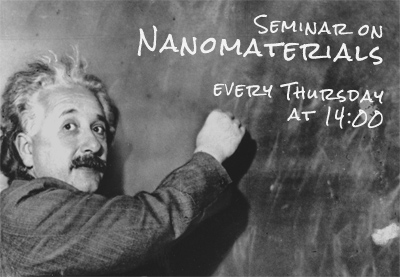Nanoseminar
Group of Structure analysis at the Department of Condensed Matter Physics
of Charles University and MGML has a pleasure to invite you to attend the seminar on nanomaterials: Physics, Technology, Applications
on 31st October 2024 at 14:00
at Faculty of Mathematics and Physics of Charles University, Ke Karlovu 5, 121 16 Praha 2
Lecture room F2
Štefan Hricov
Department of Condensed Matter Physics, Faculty of Mathematics and Physics
Iron Nitride Magnetic Nanoparticles
Štefan Hricov » Iron Nitride Magnetic Nanoparticles
Department of Condensed Matter Physics, Faculty of Mathematics and Physics
Location: F2
Many efforts have been made to investigate nanoscale magnetism showcased by magnetic nanoparticles. The reasoning for such intensive research must be sought in the proposed applications of magnetic nanoparticles. Within biomedicine, one can point out the possibility of utilizing magnetic nanoparticles as a contrast agent in diagnostic imaging or as a novel anti-cancer agent, where heat release via hyperthermia is suggested [1]. A typical example of nanomaterial with such applicability is iron oxide magnetic nanoparticles. However, we are proposing an alternative, the ε-Fe3N. Compared to its oxidic counterparts, this nanomaterial possesses unprecedented magnetic properties [2]. This work concerns the surface modification of iron nitride magnetic nanoparticles by silica encapsulation and subsequent characterization of their magnetic properties. Since synthesized magnetic nanoparticles were hydrophobic due to the oleic acid coating, we employed reverse microemulsion to grow a silica layer. We shall discuss two approaches, namely direct encapsulation under an inert atmosphere and a 2-step
process consisting of passivation of magnetic nanoparticles, followed by encapsulation under normal conditions. Surprisingly, the direct current magnetization measurements revealed the underperformance of passivated nitride magnetic nanoparticles. Thus, advanced and rigorous data analysis was utilized, consisting of numerical inversion of direct current magnetization data and Bayesian analysis. These procedures allowed us to determine how large regions from a sample’s volume contributed to the magnetization response, unveil the cross-correlations between selected parameters, and estimate their most likely values. Nevertheless, to sufficiently describe the complex magnetic nature of passivated nitride magnetic nanoparticles, Moßbauer spectroscopy and small-angle scattering experiments were performed. We shall first discuss the obtained results from small-angle X-ray scattering, which provided us with starting parameter sets for further refinement of half-polarized small-angle neutron scattering data measured under an applied magnetic field [3]. The nuclear and magnetic scattering contributions will be discussed separately. We will finalize our discussion by unraveling the magnetic properties of a passivation layer and the ε-Fe3N core by itself.
- M. L. Bauer, et al., Nanoscale, 24, 12162-12169 (2016).
- I. Dirba et al., J. Phys. D: Appl. Phys, 56, 025001 (2023).
- Hricov S., et al., Unmasking the Complex Core-Multishell Morphology of Magnetic Nanoparticles.
Institut Laue-Langevin, proposal No. DIR-297 (2023)
*corresponding author: e-mail: sterfan.hricov@matfyz.cuni.cz


